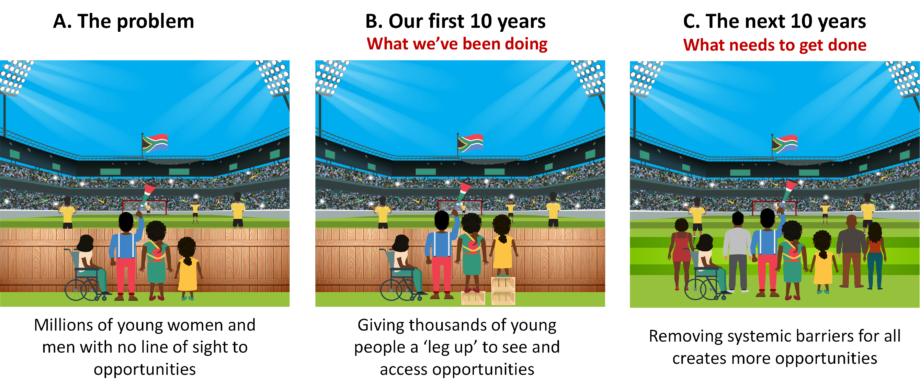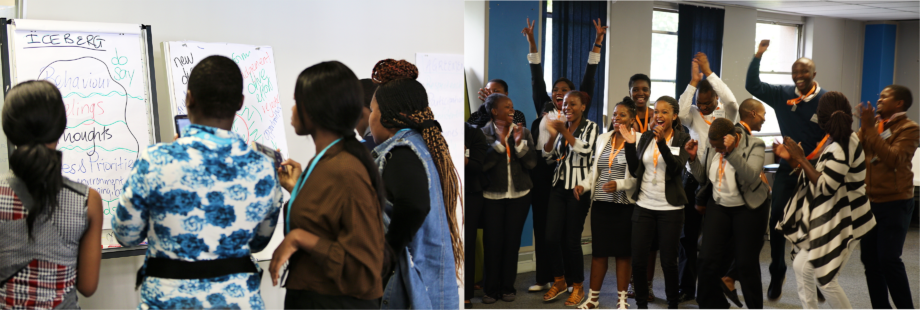
SYSTEM CHANGE – The importance of partnerships
By Laura Marras, LGT Impact Fellow at Harambee, South Africa
I am very excited to be writing this article from the Harambee office in Johannesburg, Gauteng. Despite Covid and visa delays, I’ve eventually made it to South Africa!
Last month, Harambee celebrated its 10th anniversary: we had a celebration session (virtual, of course) where a myriad of partners in the private, public and social spaces commented on the amazing work that Harambee has been doing in the space of youth employment, supporting over 1.4 million young women and men in their employment journey.
This article is about the importance of partnerships in pursuing systemic change to solve the global challenge of youth unemployment. Year 2021 marks a strategy shift for Harambee: from designing and implementing youth employment solutions, to a far wider role as a system change agent. The impact of COVID-19 has not derailed Harambee from this objective but has in fact allowed them to demonstrate their ability to pivot effectively.

Figure A – The Problem
In order to fully appreciate the massive effort that lies ahead of Harambee and its partners, it is worth quantifying the extent of the problem. South Africa has the highest youth unemployment rate in the world (World Bank). Recent studies show that 70% of people aged 15-34 were unemployed prior to the C19 pandemic: that number has now reached over 75% [Harambee analysis based on STAT SA data] . While the situation is particularly bad in South Africa, the challenge of youth unemployment is globally debated, and my hope is that the Harambee approach will be replicated around the world.
Figure B – Our first 10 years
The first 10 years of Harambee have been about understanding the problem, prototyping needs and scaling solutions. One job at a time, through innovation and partnerships, Harambee has figured out how to give young South Africans a leg up (the footstools in the middle picture) and made sure that they not only had line of sight to opportunities but that they were also work-ready for those opportunities. Since inception, Harambee has successfully engaged 1,4 million young women and men in its network and reached the important milestone of enabling over 500,000 pathways into earning opportunities (figure B).

Figure C – The next ten years
Unfortunately, there’s just not enough footstools to solve the problem at a whole-country level, and as figure C powerfully shows, systemic change can only be delivered by breaking down the barriers that too many young people still face to access employment. Upskilling them using innovative demand-led work readiness programs is essential, but in order to enable systemic change, the broader education system needs to get re-wired and the creation of new inclusive jobs has to be catalysed. In other words, we need to shift our focus from “what we do” to “what needs to get done” (by Harambee, by our partners and by the system) to enable system change.
Given the nature, complexity and size of the problem, such a system shift can only be delivered by: (i) understanding what needs to get done to break down those barriers, (ii) who in the ecosystem holds the power and levers for that to happen, and (iii) how Harambee can partner with all the relevant players to enable that shift.
So, what do we do next?
The importance of partnerships to enable system change
At Harambee we believe that system change can only be achieved through continuous innovation and collaboration. As Former Google executive and best-seller author Ann Mei Chang powerfully explains in her bestselling book “Lean Impact”, iterative testing (“think big, start small and test iteratively”) is the way forward. Once the concept is proven, scale and system shift are possible at the intersection of the private, public and social sector.
Stakeholders from Government to industry associations, from donors to social organisations, and community partnerships, all need to be convened, common objectives need to be identified, and action among participants needs to be coordinated, monitored and evaluated. Thanks to its credibility and success, and its ability to inspire change to old practices and policies, Harambee has established a very strong alliance with the SA Government and various industry bodies, and hence is best placed to act as the ecosystem facilitator of this system change program.

A successful example: the Global Business Services sector
By focusing on key growth sectors in the economy, Harambee has been able to identify, support and capacitate intermediaries to work with the key actors in these sectors in order to identify opportunities and design solutions to unlock jobs. Coordination and improved cooperation between business and government through sector-level intermediation, has been proven to deliver concrete outcomes that have tested resilient even in the face of the pandemic.
The value of this approach was well demonstrated in the global business services sector which has continued to grow and absorb young people. As a result of improved coordination across the industry body BPESA (Business Process Enabling South Africa), the government’s Department of Trade, Industry and Competition, Harambee and other partners, we have seen a doubling of inclusive jobs in this sector over the past five years, and South Africa has recently been ranked #1 global offshoring destination for Business Process Optimisation (BPO) in the Ryan Strategy Omnibus survey.
This is an incredible achievement which demonstrates how “demand creation” can actually be achieved through public-private partnerships.
The focus for the years ahead will be on scaling this approach to those growth sectors of the economy that have the potential to generate inclusive opportunities specific for youths.
Final reflection
I would like to wrap up this article with a powerful quote by Parag Mehta, the Executive Director of Mastercard’s Centre for Inclusive Growth, on the importance of partnerships:
“If you want to go deep go with NGOs,
if you want to go wide go with Government,
if you want to go fast go with private sector,
if you want to go far go together.“
Harambee – Swahili, literally meaning “pulling or working together”

About me and my role at Harambee
I filled in my application for the LGT Impact Fellowship back in February 2020, from a café in central London. We knew something about Covid at that time and the situation in Italy was actually already quite scary. But we did not know enough to make any long-term prediction. With 12y experience in Corporate Finance, I was looking for an opportunity to gain in-country experience in the Impact space and join a network of inspiring people. Thanks to LGT and Harambee, I’m now 4 months into my fellowship and I can no doubt say that, despite all the terrible events of these past 16 months, that day at Gail’s in London I made the right decision. I am so thrilled to have joined Harambee at this extremely interesting phase of their journey. The organization is going through profound changes as strategy shifts from its original operational focus to system change. It’s like having joined a start-up, but with a brilliant track-record of past successes. As budget informs strategy and therefore action, my very first priority as a new member of the Finance Team has been to develop a 5y strategic plan and a new budget structure to reflect Harambee’s system change agenda.
It’s been an incredible learning journey so far and I am extremely excited to see what the future holds for my fellowship, for Harambee and the young women and men that we are supporting!
